- Brazil
- /
- Food and Staples Retail
- /
- BOVESPA:CRFB3
Atacadão's (BVMF:CRFB3) Returns On Capital Not Reflecting Well On The Business
If you're looking for a multi-bagger, there's a few things to keep an eye out for. One common approach is to try and find a company with returns on capital employed (ROCE) that are increasing, in conjunction with a growing amount of capital employed. Basically this means that a company has profitable initiatives that it can continue to reinvest in, which is a trait of a compounding machine. However, after investigating Atacadão (BVMF:CRFB3), we don't think it's current trends fit the mold of a multi-bagger.
Return On Capital Employed (ROCE): What is it?
Just to clarify if you're unsure, ROCE is a metric for evaluating how much pre-tax income (in percentage terms) a company earns on the capital invested in its business. Analysts use this formula to calculate it for Atacadão:
Return on Capital Employed = Earnings Before Interest and Tax (EBIT) ÷ (Total Assets - Current Liabilities)
0.14 = R$4.6b ÷ (R$59b - R$25b) (Based on the trailing twelve months to March 2022).
So, Atacadão has an ROCE of 14%. On its own, that's a standard return, however it's much better than the 9.7% generated by the Consumer Retailing industry.
See our latest analysis for Atacadão

In the above chart we have measured Atacadão's prior ROCE against its prior performance, but the future is arguably more important. If you'd like, you can check out the forecasts from the analysts covering Atacadão here for free.
The Trend Of ROCE
In terms of Atacadão's historical ROCE movements, the trend isn't fantastic. To be more specific, ROCE has fallen from 20% over the last five years. However, given capital employed and revenue have both increased it appears that the business is currently pursuing growth, at the consequence of short term returns. If these investments prove successful, this can bode very well for long term stock performance.
On a side note, Atacadão's current liabilities are still rather high at 42% of total assets. This can bring about some risks because the company is basically operating with a rather large reliance on its suppliers or other sorts of short-term creditors. While it's not necessarily a bad thing, it can be beneficial if this ratio is lower.
In Conclusion...
While returns have fallen for Atacadão in recent times, we're encouraged to see that sales are growing and that the business is reinvesting in its operations. In light of this, the stock has only gained 3.8% over the last three years. So this stock may still be an appealing investment opportunity, if other fundamentals prove to be sound.
Like most companies, Atacadão does come with some risks, and we've found 1 warning sign that you should be aware of.
If you want to search for solid companies with great earnings, check out this free list of companies with good balance sheets and impressive returns on equity.
New: Manage All Your Stock Portfolios in One Place
We've created the ultimate portfolio companion for stock investors, and it's free.
• Connect an unlimited number of Portfolios and see your total in one currency
• Be alerted to new Warning Signs or Risks via email or mobile
• Track the Fair Value of your stocks
Have feedback on this article? Concerned about the content? Get in touch with us directly. Alternatively, email editorial-team (at) simplywallst.com.
This article by Simply Wall St is general in nature. We provide commentary based on historical data and analyst forecasts only using an unbiased methodology and our articles are not intended to be financial advice. It does not constitute a recommendation to buy or sell any stock, and does not take account of your objectives, or your financial situation. We aim to bring you long-term focused analysis driven by fundamental data. Note that our analysis may not factor in the latest price-sensitive company announcements or qualitative material. Simply Wall St has no position in any stocks mentioned.
About BOVESPA:CRFB3
Atacadão
Engages in the wholesale and retail of food, clothing, home appliances, electronics, and other products in Brazil.
Fair value with questionable track record.
Similar Companies
Market Insights
Community Narratives




